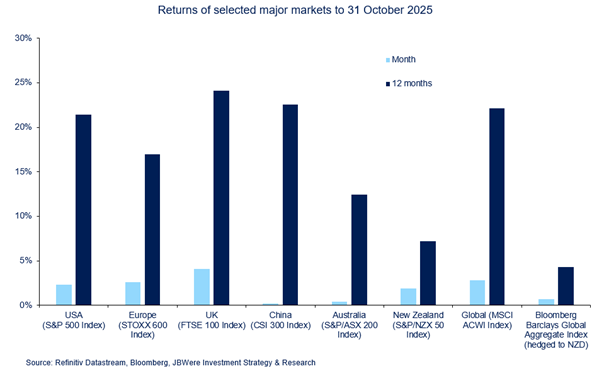14 November 2025
Key takeaways:
- The global share market1 extended its rally to 7 consecutive monthly gains.
- Global central banks were busy, with the Reserve Bank of New Zealand delivering the largest interest rate cut.
- Declining interest rates, solid technology earnings and reduced trade tensions combined to drive share markets higher.
- Japan’s share market recorded its best month in 3 decades.
Below is an in-depth review of financial markets over October.
All eyes were on a busy central bank schedule this month, as policymakers around the world assessed interest rate settings in response to shifting economic signals. It was, however, the Reserve Bank of New Zealand (RBNZ) that provided the most decisive decision. Early October, the RBNZ made a significant move by cutting the Official Cash Rate (OCR) by 0.5%, bringing it down to 2.5%. This was a larger reduction than many expected, with economists and market participants evenly split on whether the RBNZ would favour a more modest 0.25% adjustment. The 0.5% rate cut will provide a much-needed boost to the local economy and businesses. The move reflects growing concerns about a persistently stubborn economy that is proving hard to reignite. The domestic share market2 responded, gaining 1.9% in October, while bond yields fell (bond prices move in the opposite direction to bond yields).
The RBNZ said it’s open to cutting rates further if needed, depending on how the economy evolves. Following the decision, financial markets quickly adjusted expectations, pricing in another 0.25% cut in November, with a chance of another one early next year.
Other central banks were more cautious. The US Federal Reserve (Fed) approved its second consecutive interest rate cut by 0.25%, bringing the benchmark range to 3.75 - 4.00%. However, Fed Chair Jerome Powell emphasized that another cut in December is not guaranteed, citing mixed views among policymakers and ongoing uncertainty in the labour market.
The US share market3 was stable over most of October but ended the month on a strong note. The late rally was fuelled by strong earnings from major technology companies like Alphabet, Apple, and Amazon. Investor sentiment also received a boost following the Fed’s interest rate cut and a one-year trade truce between US President Trump and Chinese President Xi. The US share market finished up 2.3% (all returns are in local currency unless otherwise stated) over the month. Given the strong technology earnings results, it was not surprising to see the technology sector perform the strongest, gaining 6.2% in October. On the flipside, the financials and materials sectors experienced the largest declines, being 2 of 5 sectors to deliver a negative return over the month.
The Bank of Japan kept its interest rate unchanged at 0.5%, maintaining its ultra-loose stance despite rising inflation. Japanese shares4 were the biggest winners in October, jumping 16.6%, the Index’s largest single monthly gain since January 1994 as investor excitement grew towards the possible stimulatory policies of new Prime Minister, Takaichi. The rally was technology led by the likes of Socionext and Advantest.
Elsewhere, the European Central Bank held rates steady at 2.15%, with President Lagarde signalling a pause in policy changes for now. The European share market5 gained 0.8%, with Spain’s IBEX Index rallying 3.6%. The Bank of Canada lowered its benchmark interest rate by 0.25% to 2.25%, aiming to support a cooling economy and housing market. The Bank stressed however, that future moves will depend on inflation trends.
The differing fortunes of various market indices are illustrated in the chart below.

Note: Returns are in local currency terms.
The outlook
Global macroeconomic conditions have improved compared to earlier concerns, with solid growth and upward revisions for the US, Europe and China over recent months. Additionally, the US Federal Reserve continued monetary easing in response to a softer labour market. Historically, such easing without recession has benefited risk assets like shares. AI continues to drive market enthusiasm, attracting investment and transforming not only tech but also related industries and traditional sectors. This momentum, combined with easing monetary policy, underpins a constructive outlook for global share markets.
Perhaps the biggest challenge is that much of this positive news is already now well understood by markets. Embedded expectations are high and US equity valuations are elevated, reducing safety margins and placing greater onus on companies to deliver. Persistent macro risks, such as soft labour markets, trade disruptions, tariffs and policy uncertainties, also add complexity. While our lead investment manager, JBWere, sees the foundations for continued global share market resilience, the above factors temper their optimism modestly. Ultimately, JBWere sees risk-reward as relatively balanced, supporting the neutral tactical stance towards global shares versus strategic asset allocation targets.
Locally, despite current economic sluggishness, a recovery is expected as the RBNZ accelerates rate cuts. The weaker NZ dollar and strong rural incomes are supporting domestic conditions. JBWere believe conditions are in place for further solid performance from the local equity market.
Through all the twists and turns in markets this year, JBWere’s approach to portfolio management has not changed. Elevated uncertainty and obvious catalysts for further market volatility just reinforce the need to maintain good investment and portfolio construction discipline. This is the focus within the MAS Schemes, where our active management style allows us to regularly test and adjust conviction levels when deemed necessary. The economic and market landscape is constantly evolving. But through strong diversification and their exposures to high-quality investments, we believe the MAS Schemes are well positioned to weather what could be in store next.
We have useful online tools to help you:
- Our Fund Finder can help you see if you're in the right Fund for your circumstances.
- Our KiwiSaver Retirement Calculator can help you understand if your retirement savings are on track.
- Our MAS Investor Portal can help you manage your investments online.
If you decide to change your Fund after reviewing your risk profile or meeting with a MAS Adviser, you can make a switch via the MAS Investor Portal, or alternatively you can complete an investment strategy change request form. There is no fee for switching. Links to the relevant forms are below.
- MAS KiwiSaver Scheme: KiwiSaver Documents and Forms – MAS
- MAS Retirement Savings Scheme: Retirement Savings Scheme Documents and Forms – MAS
- MAS Investment Funds: Investment Funds Documentations and Forms
You can see weekly updates on fund unit prices and returns on our website.
1 As represented by the MSCI All Country World Index.
2 As represented by the S&P/NZX 50 Index.
3 As represented by the S&P 500 Index.
4 As represented by the Nikkei index.
5 As represented by Euro Stoxx 600 Index
This article is of a general nature and is not a substitute for professional and individually tailored advice. Medical Funds Management Limited, JBWere (NZ) Pty Ltd and Nikko Asset Management New Zealand Limited, their parent companies and associated entities do not guarantee the return of capital or the performance of investment funds. Returns indicated may bear no relation to future performance. The value of investments will fluctuate as the values of underlying assets rise or fall.
MAS is a financial advice provider. Our financial advice disclosure statement is available by visiting mas.co.nz or by calling 0800 800 627.
The Product Disclosure Statement for the MAS KiwiSaver Scheme is available: KiwiSaver – MAS
The Product Disclosure Statement for the MAS Retirement Savings Scheme is available: Retirement Savings Scheme – MAS
The Product Disclosure Statement for the MAS Investment Funds is available: Investment Funds – MAS
Medical Funds Management Limited is the issuer and manager of the Schemes.
